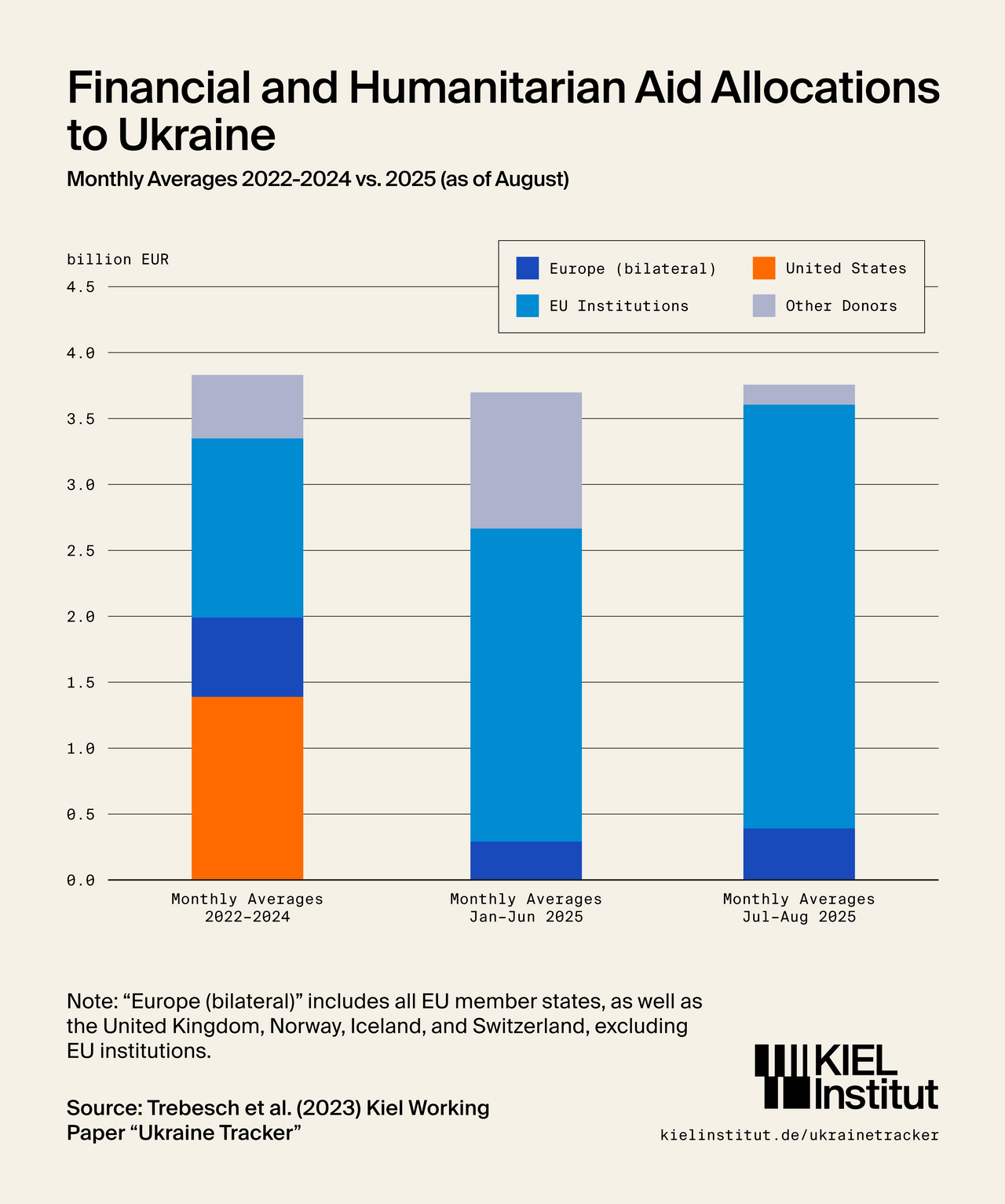Ukraine Support Tracker: Military aid falls sharply despite new NATO initiative
Military aid to Ukraine saw a sharp decline in July and August 2025, despite the introduction of NATO’s Prioritized Ukraine Requirements List (PURL) initiative. In contrast, financial and humanitarian aid remained stable and is mainly provided by EU institutions. This is shown in the latest update of the Ukraine Support Tracker, which records international aid flows to Ukraine through August 2025.
Most of the military aid during the observation period came from the new NATO PURL initiative. It was agreed in July at a meeting between NATO Secretary General Mark Rutte and US President Donald Trump and enables NATO to acquire “ready-to-use” weapons from US stockpiles for Ukraine, financed by other member states. By August, eight NATO countries had participated: Belgium, Canada, Denmark, Germany, Latvia, the Netherlands, Norway, and Sweden. They allocated a total of EUR 1.9 billion.
Military aid falls by 43 percent compared to the first half of the year
Although the new mechanism was launched, military aid declined significantly in July and August. After the US stopped announcing new aid packages at the beginning of 2025, European countries stepped in and significantly expanded their military support. As a result, the monthly average of military aid allocations in the first half of 2025 exceeded those of 2022–2024—despite the lack of US contributions. However, this momentum collapsed in the summer: military allocations from European countries fell by 57 percent compared to January–June 2025, even when their contributions to the NATO PURL initiative were included. The reduction in military support from Europe was, however, partly offset by higher allocations from other countries. Most notably, Canada announced EUR 1.2 billion in military aid in August, part of which was channeled through NATO’s PURL mechanism. If we count total aid — including by European donors and others — the monthly aid decline was 43%.

“As military support for Ukraine increasingly depends on new weapons procurement—which often takes months or even years to implement—the NATO PURL initiative is an important vehicle to provide Ukraine with ready-to-use weapons from US stockpiles,” says Christoph Trebesch, head of the Ukraine Support Tracker and Research Director at the Kiel Institute. “At the same time, the decline in military aid in July and August is surprising. Despite the NATO PURL initiative, Europe is scaling back its overall military support. What will be crucial now is how the figures evolve in the autumn.”
EU maintains high level of civilian aid
Between July and August, EUR 7.5 billion in financial and humanitarian aid was allocated, which is in line with previous years and the first half of this year. Of the newly allocated funds, 86 percent originate from EU institutions, including new tranches under the Ukraine Facility (EUR 5.4 billion) and the ERA Loan Mechanism (EUR 1 billion).
“The overall level of financial and humanitarian support has remained comparatively stable—even in the absence of US contributions,” noted Christoph Trebesch. “It is now crucial that this stability extends to military support as well, as Ukraine relies on it to sustain its defense efforts on the ground.”

About the Ukraine Support Tracker
The Ukraine Support Tracker tracks and quantifies military, financial, and humanitarian assistance pledged to Ukraine since January 24, 2022. Included are 41 countries, specifically the EU member states, the other members of the G7, Australia, South Korea, Turkey, Norway, New Zealand, Switzerland, Turkey, China, Taiwan, India, and Iceland. It includes pledges made by the governments of these countries to the Ukrainian government; aid pledged by the EU Commission and the European Investment Bank is listed separately; private donations or those from international organizations such as the IMF are not included in the main database. Nor does it include aid to Ukraine's neighbors, such as Moldova, or to other countries, such as for the reception of refugees.
Data sources include official government announcements and international media reports. Aid in kind, such as medical supplies, food, or military equipment, is estimated using market prices or information from previous relief operations. In cases of doubt, the higher available value is used. The Ukraine Support Tracker is constantly being expanded, corrected and improved. Feedback and comments on our methodology paper and dataset are very welcome. You can reach us at ukrainetracker@ifw-kiel.de.
More charts and all detailed data:




